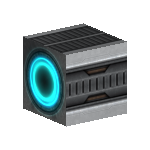Thruster Module
| Thruster Module | |
|---|---|
 | |
| Hit Points | 100 |
| Armor | - |
| Luminosity | no |
| Data Value (ID) | 8 |
| This page is currently a stub. Please help us out by expanding it. |
Thruster Modules are the primary propulsion method in the game. Their main role is for combat maneuvering and short-range travel, either within sectors, or through a small number thereof. For longer-range travel, Jump Drives will prove faster and more efficient.
Item Description
"The Thruster Module is capable of providing propulsion for ships of all shapes and sizes. Their main fuel source is power, taken from the ships Power Capacitors."
Production
| Production Info | |||||
|---|---|---|---|---|---|
| Produced in a | Basic Factory |  |
|||
| Requires | To create | ||||
| Alloyed Metal Mesh | x25 |
 |
Thruster Module | x1 |
 |
| Crystal Composite | x25 |
 |
|||
Resource
This element is used in the production of:
| Factory | Creates | Amount used | |
|---|---|---|---|
| Advanced Factory | |||
| Repulse Module | x6 | ||
Usage
- Main article: Propulsion Systems
Thruster Modules do not require linking in order to operate, they simply need to be placed on a ship. They require power to operate, and generate a certain amount of thrust based on the number of them attached to a ship. They do not have any grouping mechanics; two physically separate Thruster Modules will have the same effect as two which are adjacent to each other. The exact values for thrust generation and power consumption can be calculated by the formulas shown below.
A large ship will require a greater number of Thruster Modules to achieve the same acceleration and top speed as a smaller ship with the same proportion of thrusters. This is because the acceleration of a ship is determined by its thrust:mass ratio, and also because the thrust generated by each consecutive Thruster Module added to a ship suffers from diminishing returns - each module added will increase thrust by slightly less than the one before it, meaning that smaller ships have a decided advantage in reaching higher thrust:mass ratios, and therefore higher levels of acceleration and top speed.
Pressing R on a thruster will bring up the Thrust Management Menu. This menu allows precise control of a ship's thrust allocation, between rotation control and 3 sets of vectors:
- Rotational (Default 50%).
- Forward/Back (Default 16.666%, rounded to 17%).
- Left/Right (Default 16.666%, rounded to 17%).
- Up/Down (Default 16.666%, rounded to 17%).
This menu also allows the toggling of inertial dampening, which gradually slows down a ship when it is not receiving any movement input. By default, "Reactivate Damping on Exit" is on, which activates inertial dampening when the pilot leaves the core, decreasing the likelihood of a ship being lost. "Auto-Dampeners" can also be toggled on, which causes constant inertial dampening, whenever the pilot is not pressing a movement input key (either W, S, A, D, Space, or Left Control). on Thrusters, like Power Reactors, have a relatively high SHP contribution alongside very little individual block HP. This can make them a vulnerable target in comparison to sturdier system blocks such as shield modules.
Thruster Rules
The power cost, thrust output, and maximum speed provided by a ship's thrusters are given by the formulas listed below. The table serves to explain the different values involved.
| Symbol | Value |
|---|---|
| N | Number of Thruster Modules on the ship |
| P | Power cost per second of use |
| T | Thrust generated |
| R | Ratio of thrust output:mass of ship |
| M | Maximum speed of ship |
| S | Server speed setting in config |
The power usage per second of a thruster system (when they are in use) is given by this formula:
P = 25N
The power usage per second of a thruster system (when they are NOT in use) is given by this formula:
P = 2.5N
The thrust output of a given number of thrusters is given by this formula:
T = 45N0.75
The maximum speed of a ship, based on the server's maximum speed setting (75, assuming default configuration), is given by this formula:
M = 75R + 75
Where R is the thrust output of the ship divided by the mass of the ship (and all docked entities), with a maximum value of 5.
